Has GLD Been Failing to Disclose Gold Held at BoE in 2022?
Readers of these pages will be familiar that in addition to holding its gold bars in a HSBC vault in London, the SPDR Gold Trust (GLD), the world’s largest gold-backed ETF, at times also holds some of its gold bars in the vaults of the ‘Bank of England’ in London.
This is because while HSBC bank plc is the gold custodian of the SPDR Gold Trust (responsible for the storage and safekeeping of GLD’s gold bars), the Bank of England is one of the GLD’s gold storage sub-custodians. This ability of HSBC to use sub-custodians is an arrangement defined in the “Allocated Precious Metal Account Agreement” between HSBC (the custodian) and the Bank of New York Mellon (the Trustee of the SPDR Gold Trust).
Note, this custodian agreement with HSBC was amended in 2014, changing the custodian from “HSBC Bank NA USA” to ‘HSBC Bank plc’, but that was just a change from one HSBC entity to another.
Note also that from 30 November 2022, JP Morgan has also been appointed as a second gold custodian of the SPDR Gold Trust (GLD), and JP Morgan also now has its own ‘Allocated Precious Metal Account Agreement’ with Bank of New York Mellon.
However, the discussion here relates to the SPDR Gold Trust (GLD), its Sponsor (World Gold Trust Services), its custodian HSBC, and one of its sub-custodians- the ‘Bank of England’, prior to JP Morgan being appointed as the second custodian of GLD.
2020 – 70 tonnes of GLD gold at the Bank of England
Below you will see that there are plenty of examples of the Bank of England being used as a sub-custodian of gold bars of the SPDR Gold Trust. For example, over the 4 month period between 15 April 2020 and 13 August 2020, GLD held a substantial amount of gold at the Bank of England, in fact up to 70 tonnes of GLD gold was being stored at the Bank of England at one point during that 4 month period in 2020, and GLD gold may have been churning out of the Bank of England vaults into the HSBC vaults all of that time.
All of which is documented in the following BullionStar articles:
13 May 2020 “Amid London gold turmoil, HSBC taps Bank of England for GLD gold bars”
14 August 2020 “GLD continues to source gold at the Bank of England, at an escalating rate”
10 December 2020 “GLD 10-K omits BoE gold holdings data, GLD CFO left 1 day before financial year-end”

The reason that GLD’s use of sub-custodians is public knowledge (and which enables such articles as these to be written), is that GLD, as a US stock-exchange listed Trust, legally requires the Sponsor of the SPDR Gold Trust (World Gold Trust Services, a Manhattan based fully-owned subsidiary of the World Gold Council) to file quarterly (10-Q) and annual (10-K) reports with the US Securities and Exchange Commission (SEC).
The 10-Q reports are signed off by the Chief Financial Officer (CFO) of World Gold Trust Services (the GLD Sponsor). The Sponsor in essence manages and promotes the Trust. The 10-K (annual) reports are signed off by the CFO and CEO World Gold Trust Services, and also by the board members of World Gold Trust Services.
SEC Letter to GLD Sponsor – 2016
The GLD Sponsor is also required by the SEC to specifically state how much of the GLD gold is being held by a sub-custodian during any reporting period (quarterly and annual). The SEC even reminded the Sponsor of this obligation on 29 March 2016 when it wrote a letter to World Gold Trust Services pointing out the fact that the Sponsor is obligated to report gold held by sub-custodians. As per the SEC letter:
“We understand that the Custodian may appoint one or more subcustodians to hold the Trust’s gold and that the Custodian currently uses a number of subcustodians, identified on page 18.
You also outline risks that may arise in connection with the use of subcustodians.
In future Exchange Act periodic reports, to the extent material, please disclose the amount of the Trust’s assets that are held by subcustodians.”
The SEC’s 29 March 2016 letter was addressed to William Rhind, who had been CEO of the Sponsor, but had actually resigned on 12 February 2016. The SEC Letter asked the Sponsor to be more specific about gold held with a sub-custodian, and was sent to the Sponsor because in the 10-Q reports for Q1 and Q2 of 2016, the Sponsor was being cagey with the way it explained how much gold was being held at the Bank of England.
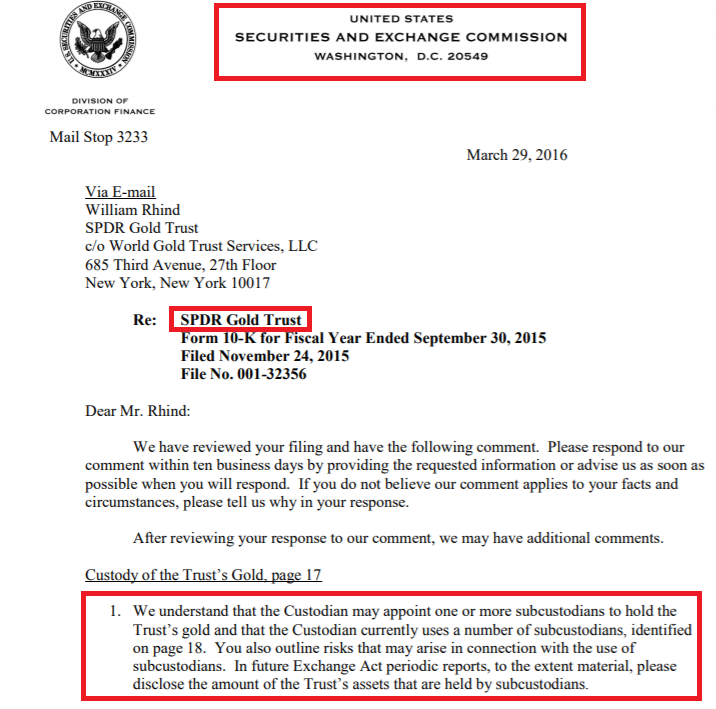
As you can see below, the 10-Q from Q4 2015 used selective wording, only stating that GLD held no sub-custodied gold on the quarter end date.
“As at December 31, 2015, the Custodian held 20,691,044 ounces of gold on behalf of the Trust in its vault, 100% of which is allocated gold in the form of London Good Delivery gold bars with a market value of $21,979,061,920 (cost — $25,333,180,858) based on the LBMA Gold Price AM on December 31, 2015.
Subcustodians held nil ounces of gold in their vaults on behalf of the Trust…”
Source: GLD 10-Q to 31 December 2015
Following the SEC’s letter dated 29 March 2016, the Sponsor was forced to be more transparent, and for example during Q1 2016 the Sponsor then stated that the maximum amount of gold held at the Bank of England during the quarter (which was 29 tonnes):
“Results of Operations
Subcustodians held no gold on behalf of the Trust as of March 31, 2016. During the quarter ended March 31, 2016, the greatest amount of gold held by subcustodians was approximately 29 tonnes or approximately 3.8% of the Trust’s gold at such date. The Bank of England held that gold as subcustodian.”
Source: GLD 10-Q to 31 March 2016
For details of these 2015 -2016 developments, see the BullionStar article from 11 July 2016 titled “SPDR Gold Trust gold bars being held at the Bank of England”.
Still though, the GLD Sponsor reverted to its opaque and ambiguous reporting for the second quarter 10-Q, i.e. over the 3 months from April 2016 to June 2016, and merely just repeated the information that GLD held a maximum of 29 tonnes over a nine month period, but failed to say if GLD held any gold at the bank of England during April, May and June 2016:
“Results of Operations
Subcustodians held no gold on behalf of the Trust as of June 30, 2016. During the nine months ended June 30, 2016, the greatest amount of gold held by subcustodians was approximately 29 tonnes or approximately 3.8% of the Trust’s gold at such date. The Bank of England held that gold as subcustodian.”
Source: GLD 10-Q to 30 June 2016
All of which is documented in the BullionStar article from 2 August 2016, titled “GLD Sponsor dodges disclosure details of Bank of England sub-custodian in latest SEC filing”.
Why the SEC didn’t pick up on the Sponsor’s continued evasion is baffling, but at least following the SEC letter of 29 September 2016, the 10-Q and 10-K ‘Exchange Act periodic reports’ submitted to the SEC by the GLD Sponsor (World Gold Trust Services) became more informative about sub-custodian held gold than before.
Example 1:
“Gold is held by HSBC Bank plc (the “Custodian”) on behalf of the Trust. During the three month period ended December 31, 2016, no gold was held by a subcustodian.
During the year ended September 30, 2016, the only time gold was held by a subcustodian (the Bank of England) was during the period January through March and the greatest amount of gold held during such period was approximately 29 tonnes, or approximately 3.8% of the Trust’s gold at the time.”
Source: GLD 10-Q for the 3 month period to 31 December 2016
Example 2:
“2.3 Custody of Gold:
Gold is held by HSBC Bank plc, on behalf of the Trust. During the years ended September 30, 2018 and 2017, no gold was held by a subcustodian.”
Source: GLD 10-K for the year to 30 September 2018
Example 3:
“Subsequent Events:
Since April 15, 2020, gold was held by a subcustodian (the Bank of England) and the greatest amount of gold held on April 27, 2020 was approximately 45.91 tonnes or 4.4% of the Trust’s gold.”
Source: GLD 10-Q for the 3 months to 30 March 2020
Example 4:
“Gold is held by the Custodian on behalf of the Trust, 100% of which is allocated gold in the form of good delivery gold bars which includes gold held with a subcustodian (Bank of England).
The greatest amount of gold held by Bank of England during the quarter ended June 30, 2020 was approximately 2,251,607 ounces or 6.3% of the Trust’s gold on May 21, 2020.
At June 30, 2020, Bank of England held approximately 1,283,665 ounces or 3.4% of the Trust’s gold in an allocated account.
No gold was held by a subcustodian during the year ended September 30, 2019 or the six months ended March 31, 2020.”
Source: GLD 10-Q for the three months to 30 June 2020
Example 5:
“2.3. Custody of Gold"
During the year ended September 30, 2020, some gold was held with a subcustodian (the Bank of England) from April 15, 2020 to August 13, 2020.
Since August 13, 2020, subcustodians have not held any gold on behalf of the Trust. During the year ended September 30, 2019, no gold was held by a subcustodian.”
Source: GLD 10-K for the year to 30 September 2020
So you get the picture on how specific the GLD 10-Q and 10-K filings can be when the Sponsor wishes to be transparent.
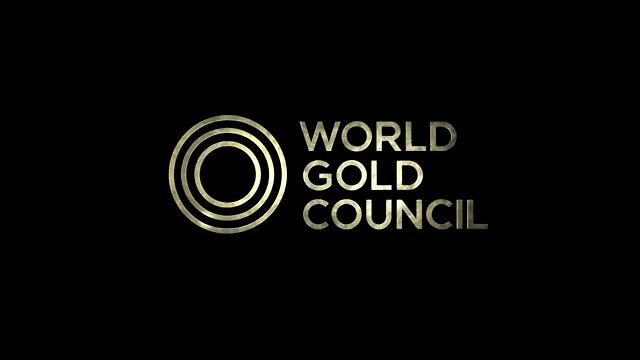
2022: Removal of all references to Sub-Custodians
Which is why it was very interesting to note that starting in Q1 2022, the GLD Sponsor, Word Gold Trust Services, changed the wording of its 10-Q and 10-K reports and began not to report anything to do with gold held by the Trust’s sub-custodians, a censoring move which is in direct breach of its Exchange Act periodic reporting requirements and in breach of the SEC’s guidance.
In short, the GLD Sponsor is now being totally untransparent and avoiding even discussing gold held with sub-custodians. Why would they do this? The most obvious reason would be so as to suppress any discussion of GLD’s gold bars being held at the Bank of England, i.e. to prevent the spotlight being shone on the Bank of England acting as lender of last resort in lending gold to the SPDR Gold Trust, a.k.a. to prevent the spotlight being shone on any borrowed central bank gold that is being held by the SPDR Gold Trust.
This gold would be gold borrowed by bullion banks from central banks (facilitated by the Bank of England’s internal gold lending market at the Bank of England). The Authorised Participants of GLD (almost all of which are bullion banks) borrow the gold and deliver it into the SPDR Gold Trust.
Up to and including the end of 2021, the relevant section of the 10-Q filings to the SEC (2.3 Custody of Gold), either said that “no gold was held by a subcustodian“, or alternatively stated that gold was held by a subcustodian, and the filing provided data as to how much sub-custodied gold GLD held.
For example, the 10-Q for the 3 months to 31 December 2021, stated that:
“2.3. Custody of Gold
Gold is held by the Custodian on behalf of the Trust, 100% of which is allocated gold in the form of good delivery gold bars which includes gold held with a subcustodian.
During the three months ended December 31, 2021, no gold was held by a subcustodian."
Source: GLD 10-Q to 31 December 2021

However, starting in Q1 2022, in the 10-Q report for the 3 months to 31 March 2022, the Sponsor (World Gold Trust Services) has introduced disingenuous weasel wording, so as not to specify whether any gold has been held by a sub-custodian during the reporting period, and the wording now says:
“2.3. Custody of Gold
Gold is held by the Custodian on behalf of the Trust, 100% of which is allocated gold in the form of good delivery gold bars.
A current list of all gold held by the Custodian, including any held with a subcustodian is available on the sponsor’s website at www.spdrgoldshares.com."
Source: GLD 10-Q to 31 March 2022

As well as having deleted any reference to gold held by sub-custodians over the time period of the filing, and as well as having masked and omitted all active XBRL tags, the Sponsor has literally just amended what was the first line of the 2.3 Custody of Gold section of the filings, keeping the part about “Gold is held by the Custodian on behalf of the Trust, 100% of which is allocated gold in the form of good delivery gold bar”, and then wrapping new text around each side of the phrase “which includes gold held with a subcustodian”, i.e. adding the words “A current list of all gold held by the Custodian” before, and “is available on the sponsor’s website at www.spdrgoldshares.com” after.
The question is, who in World Gold Trust Services (the Sponsor) made this change, and who authorised this change? If there was no gold held by a custodian during the quarter of the filing, then why not state this?
Apart from being in breach of SEC guidelines, this entire change in reporting is highly suspicious in many ways.
Instead of investors being able to look at “on the record” periodic filings on the SEC EDGAR database and see if GLD had been holding gold with a subcustodian over any quarterly or annual reporting period, investors are being told to monitor the SPDR GoldShares website every day.
The wording in the 10-Q and 10-K reports doesn’t even say where to look on that website, although the only place it could be is the GLD bar list from HSBC. So its deliberate obfuscation and deliberately making this search cumbersome and confusing.
It is also removing from official filings to the SEC any potential references of GLD gold held being held with sub-custodians such as the Bank of England.
There is also no correspondence from the SEC or from the GLD Sponsor filed under the SPDR Gold Trust on the EDGAR database authorizing or asking for such an important change, the conclusion being that there was no authorization from the SEC to make this change to the reporting process, and no request from the GLD Sponsor to the SEC to make this change.
The new wording in the filings about custody and sub-custody and the actual files submitted by the Sponsor to the SEC also totally ignore the use of XBRL format data in the financial statement information. XBRL format is eXtensible Business Reporting Language.
We’ll get to this below about why XBRL is important and why cutting out this information is a breach of the SEC guidance, but for now it means that the GLD Sponsor and HSBC have masked and suppressed data fields which contain all the information about holdings with sub-custodians, despite having all of these data fields and their values at their disposal in their accounting and gold bar recording systems.
The New Wording and the HSBC Vault
Let’s look at the new wording which the GLD Sponsor has snuck into the 10-Q and 10-K reports. The wording is:
“A current list of all gold held by the Custodian, including any held with a subcustodian is available on the sponsor’s website at www.spdrgoldshares.com."
The new wording i.e. “including any held with a subcustodian" could be construed as meaning, if any gold has been held with a subcustodian on any days, then it will be listed as such in the GLD bar list file.
However, it could also mean that “a current list of all gold held by the Custodian [being a list which includes any gold held with a subcustodian] is available on the sponsor’s website at www.spdrgoldshares.com.
i.e. they could be saying “the GLD bar list…which is a list that includes any gold held at a custodian, but without us saying which gold is held at a subcustodian, … is available on the sponsor’s website.“
Therefore the wording is totally ambiguous and misleading. How’s that for an official filing to the US SEC? Ambiguous and misleading.
When you look at HSBC’s GLD bar list link here, which is updated on the SPDR Gold Trust website each business day and so which only ever has one live occurrence, all you see is a column titled ‘VAULT NAME’ which for every gold bar on the list just says “HSBC VAULT”. As of 16 December 2022, the list shows 71,994 gold bars all attributed to a database field value of ‘HSBC VAULT”. This is hardly helpful.
I asked ETF gold bar expert Warren James for his view on this bar list column, and to check whether this ‘VAULT NAME’ column had ever been populated with anything other than ‘HSBC VAULT’. Warren maintains a database that’s populated with all the daily bar lists of ETFs such as GLD and (for silver) SLV, and so can query changes to GLD’s holdings and the contents of the GLD bars lists all the way back to the launch of the GLD Trust.
Straight up, Warren said that “the ‘Vault Name’ as “HSBC VAULT” is just too general, it really could just mean ‘a vault that HSBC uses’, and is nearly completely different to the way the SLV document uses it.” SLV is the iShares Silver Trust.
Warren then ran a query to capture all instances in the daily GLD bar list files where the ‘VAULT NAME’ has been populated. Warren made the discovery that the ‘VAULT NAME’ column was only added to the HSBC report starting 6 September 2020, and this column has never been populated with anything other than the phrase ‘HSBC VAULT’. Warren’s findings are as follows:
‘Vault Name’ is a column first introduced to the GLD bar list starting in September 2020 and (to date) has become a permanent feature of the document.
FIRST APPEARANCE: “GLD.20200906.074744.FastReport.pdf”. i.e on 6th September 2020
In EVERY DOCUMENT the value has been just ‘HSBC VAULT’ and has not changed.
Warren’s query processed 453 unique GLD Documents ranging from 20200906 to 20221206: ALL Vault locations showed ‘HSBC VAULT’ as the only vault name.
I had initially asked Warren to check what the ‘VAULT NAME’ values showed for the period 15 April 2020 – 13 August 2020, which was when we know that there was a lot of GLD gold bars being held in the Bank of England vaults in London. See here for background.
Warren commented “It’s noteworthy you were interested in the period 15 April 2020 – 13 August 2020: unfortunately the documents for that time period do not specify vault location – it only appeared in September 2020.”
Therefore, the custodian HSBC only added this ‘VAULT NAME’ field exactly 3 weeks after 13 August 2020, i.e. 3 weeks after it moved gold bars out of the Bank of England vaults following a period of 4 months during which the GLD had held substantial quantities of gold in the Bank of England vaults.
Warren continued:
“Because the field data does not vary, I assume it was added purely to satisfy a compliance requirement and was never intended to reveal additional information.”
“If we had proof that multiple vaults were in use during the time period indicated then we could at least use this data result to prove ‘HSBC VAULT’ is a collective descriptor rather than an actual named location.”
The timing on 13 August 2020 of the SPDR Gold Trust ceasing to hold gold at the Bank of England vaults is very interesting as it came exactly one day after BullionStar continued to highlight on 12 August 2020 that GLD had been holding massive quantities of gold in those very same Bank of England vaults. See Tweet below:
STOP THE PRESS (Latest GLD 10Q filing 10 Aug): On 21 May, the SPDR Gold Trust (GLD) was holding 70 tonnes of gold at subcustodian the Bank of England. On 30 June, the GLD held 40 tonnes of gold at the Bank of England. This is borrowed central bank gold. https://t.co/KX3u8uqn9i pic.twitter.com/sdNlgqJiDF
— BullionStar (@BullionStar) August 12, 2020
It’s also very interesting timing that the GLD gold bar list added the column for ‘Vault Name” just 3 weeks after GLD stopped holding gold at the Bank of England. GLD gold was held at the Bank of England over the period 15 April to 13 August 2020 and the first bar list with the additional field was on 6 September 2020.
The SPDR Gold Trust and its various participants such as Custodian, Trustee, Sponsor and Authorised Participants (APs) obviously don’t like the publicity of investors and media knowing when the GLD is holding gold bars at the Bank of England. Why? Because that gold is ultimately central bank gold borrowed by bullion banks at the Bank of England, with the Bank of England acting as lender of last resort using its central bank clients’ gold.
The phrase ‘HSBC Vault’ is also so generic, it could mean anything, including one of HSBC’s own vaults, but also a space designated and ring-fenced by another vault provider (such as the sub-custodian Bank of England), in which the gold bars of ‘client HSBC’ are stored, and which is not reported as central bank gold or commercial bank gold. So straight away, you can see the ambiguity here.
Did HSBC add the field vault location on 6 September 2020 so as to populate it with a non-changing value of “HSBC VAULT", which could be a “a collective descriptor rather than an actual named location“?
And why would HSBC add this extra column to the GLD gold bar list at that time, rather than just leave the GLD gold bar list the way it was without this extra column? One interpretation is that in the future (after September 2020), if GLD held gold again at the Bank of England, then not only would the bar list not show it, but a field name of ‘Vault Location’ (that’s populated with an unchanging value) would throw anyone off the scent that gold was being held at the Bank of England, as it would merely from that date onwards always say ‘HSBC VAULT’.
The final part of the scheme, when GLD did again start holding gold at the Bank of England, would be to then change the 10-Q and 10-K reports and mask the XBRL data, so that instead of the quarterly and annual report filings mentioning how much gold was held with a sub-custodian, they now merely say: – “A current list of all gold held by the Custodian, including any held with a subcustodian is available on the Sponsor’s website at www.spdrgoldshares.com."
And when anyone looks at the bar list now, all it will say is ‘HSBC VAULT’. In this way, not only does World Gold Trust Services (WGTS) (the Sponsor) not mention how much gold is held with a sub-custodian, neither does the GLD gold bar list.
XBRL in 10-Q and 10-K filings to the SEC
In an article dated 10 December 2020, I explained why the XBRL attributes / tags / fields are important to SEC filings for gold that is under sub-custody in GLD. The discussion can be seen here in the article titled “GLD 10-K omits BoE gold holdings data, GLD CFO left 1 day before financial year-end" in the section titled “The BoE Data is Available – XBRL".
“Since 2018, the SEC has required that financial statement information be submitted to it in XBRL format (eXtensible Business Reporting Language), where submission filers such as the GLD Sponsor WGTS embed XBRL data directly into HTML versions of documents such as 10-K and 10Q filings.
Using XBRL, data and numbers are rendered dynamically ‘in line’ in these documents and controlled by XBRL attributes and tags, with the data appearing as clickable hyperlinked tags with red underline (see screenshot below).
And indeed, in compliance with these SEC requirements, the GLD quarterly 10-Q financial reports to the end of March 2020 and end of June 2020 both use these embedded XBRL tags when quoting quantity values for GLD gold held at the Bank of England."

These tags referenced attributes that captured how much GLD gold in troy ounces was a) held in a sub-custodian vaults on any given day (Gold Held in Vault Other Measures), b) how much GLD gold (as a percentage of all GLD gold) was held in a sub-custodian vault on any given day (Percentage of Trust Gold Held in Vault), and c) the quantity of GLD gold that was held by a Sub-Custodian over a given period of time (Gold held by SubCustodian). When you clicked on these tags in the 10-Q and 10-K reports, they opened pop-up Attribute windows – see below for examples.
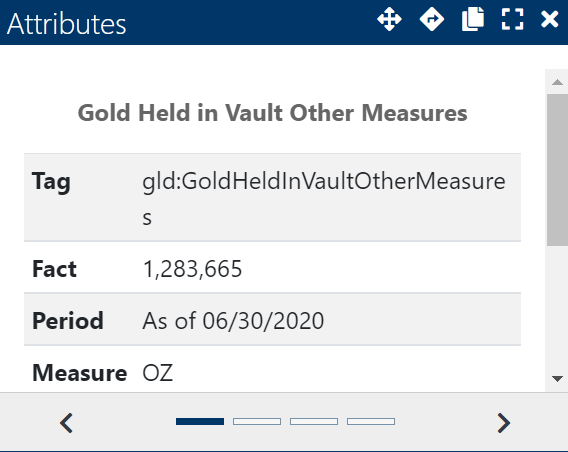
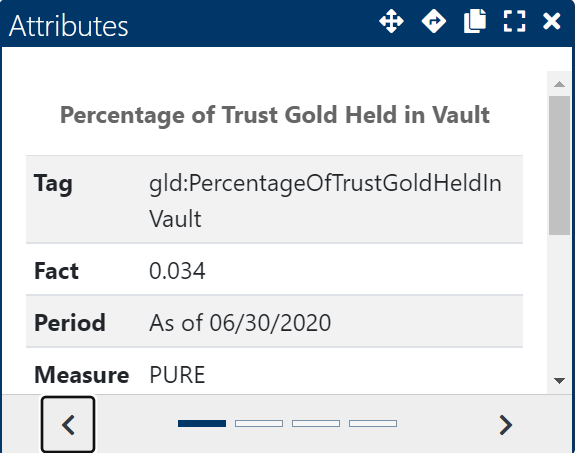
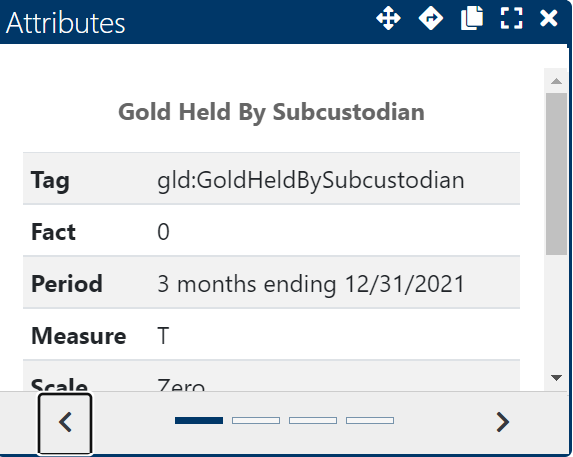
Prior to the wording change of Q1 2022, the XBRL files which accompanied GLD filing submissions to the SEC, such as the “XBRL TAXONOMY EXTENSION SCHEMA", contained definitions for these elements and links:
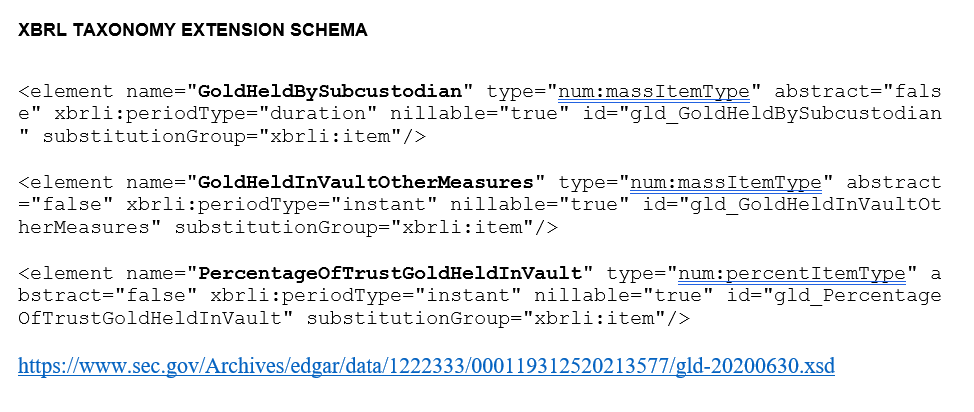
By changing the wording and formatting in the 10-K and 10-Q reports that referred to sub-custodians, the GLD Sponsor has now suppressed and masked these tags, and prevented current and future GLD filings to the SEC from using this important XBRL information about sub-custodian holdings of GLD gold.
Red Flag CFO Departures
A critical point about the wording changes on the 10-Q and 10-K reports, which dropped any discussion of sub-custodians holding GLD gold, is that the changes were implemented during the quarter (Q1 2022) in which the CFO of the GLD Sponsor abrupted departed, a move which led to the CEO of the World Gold Trust Services CEO becoming interim CFO. Yes, you read that correctly.
The actual title of the CFO role at the GLD Sponsor has been on occasion either “Principal Financial and Accounting Officer”, or “Chief Financial Officer and Treasurer", but we will use CFO here for brevity.
The quarterly report that dropped discussion of sub-custodians holding GLD gold is the 10-Q for the 3 months to 31 March 2022. It was during this quarter, that Brandon Woods, the Sponsor CFO at that time, resigned on 9 February 2022.
As per a 8-K GLD filing to the SEC dated 11 February 2022:
“On February 9, 2022, Brandon Woods resigned as Principal Financial and Accounting Officer of World Gold Trust Services, LLC, or WGTS, the Sponsor of the SPDR® Gold Trust, effective March 11, 2022. His resignation did not arise from any disagreement on any matter relating to the operations, policies or practices of the SPDR® Gold Trust.”
The same filing shows that when Brandon Woods resigned, he was replaced two days later (on an interim basis) by Joseph R. Cavatoni, the Principal Executive Officer of WGTS"
“On February 11, 2022, WGTS appointed Joseph R. Cavatoni, the Principal Executive Officer of WGTS, to also serve as interim Principal Financial and Accounting Officer of WGTS, with effect from March 11, 2022.”
So it was Joseph R. Cavatoni, the de facto CEO of GLD, who signed off on GLD’s quarterly results for the 3 months to 31 March 2022, i.e. the quarter in which the wording about the sub-custodian was changed.

The fact that Brandon Woods was not replaced by a new CFO on the same day that be resigned shows that his resignation was abrupt and unexpected, since no replacement CFO had been lined up to take his place.
In fact, WGTS then took another 8 months to appoint a new non-interim CFO, and only appointed a new full-time CFO, Amanda Krichman, on 13 October 2022. And so Joseph R. Cavatoni, the GLD CEO, remained as interim CFO of GLD all the way from 11 February 2022 until 13 October 2022.
You will also see below, that there has been a very high volume of turnover among GLD CFO’s since 2014 (a full EIGHT CFOs of the GLD Sponsor since 2014), but even so, when those CFO changes happened, the GLD CFO role almost always transitioned seamlessly from one CFO to another, not from a CFO to an interim CFO (in the shape of the CEO).
So, why did the CFO, Brandon Woods resign mid-quarter and not after he had signed off on the Q1 2022 financial statements?
The GLD CFO prior to Brandon Woods also resigned abruptly in September 2020. The CFO of GLD prior to Brandon Woods was Laura Melman. Outrageously, Melman departed the GLD Sponsor on 29 September 2020, one day before she should have signed off the Annual 2020 SPDR Gold Trust accounts for the year to 30 September 2020. The language used in the 8-K report that divulged that information was that she ‘ceased’ to serve as CFO.
 Whoever heard of a CFO resigning one day before having to sign off on annual financial accounts? The timing of Melman’s departure, as well as being totally unprecedented for the largest gold-backed ETF in the world, was also 3 weeks after the GLD custodian added the ‘VAULT NAME’ column to the GLD gold bar list, populated with the words “HSBC VAULT”.
Whoever heard of a CFO resigning one day before having to sign off on annual financial accounts? The timing of Melman’s departure, as well as being totally unprecedented for the largest gold-backed ETF in the world, was also 3 weeks after the GLD custodian added the ‘VAULT NAME’ column to the GLD gold bar list, populated with the words “HSBC VAULT”.
In fact, Melman’s exit on 29 September 2020 then led the Sponsor to ‘on the spur of the moment’ appoint Brandon Woods as CFO. Yes, you read that correctly also. Woods had up until that time been ‘Head of Compliance and Reporting’ at the GLD Sponsor. So there was no search on the market for a new CFO when Melman departed. Woods was drafted in “to serve as Principal Financial and Accounting Officer of WGTS, effective immediately" (maybe even while at the water cooler).
More about the GLD CFOs
Since 2014, there have been an astonishing 7 people working as the CFO for the GLD Sponsor (World Gold Trust Services), a role which is responsible for the financial filings of the SPDR Gold Trust. An incredible 5 of who have resigned over that same period, and one of those people held the role twice on a temporary basis. In summary, the CFOs were
Robin Lee: H1 2010 – Left WGTS / WGC December 2014
Adrian Pound: Appointed Oct 2013 – Resigned 10 March 2016
Samantha McDonald: Appointed March 2016, resigned 20 October 2017
Joseph R. Cavatoni – interim Chief Financial Officer and Treasurer from 23 October 2017 to 28 February 2018
Laura S. Melman appointed 28 February 2018, ‘ceased’ to serve in role on 29 September 2020.
Brandon Woods appointed 29 September 2020, resigned (mid way through Q1 2022) on 9 February 2022.
Joseph R. Cavatoni (again) served as interim Principal Financial and Accounting Officer from 11 February 2022 until 13 October 2022
Amanda Krichman appointed 13 October 2022.
For more details, see BullionStar articles:
“Execs flee GLD – The revolving door at the SPDR Gold Trust Sponsor" (July 2016)
“Revolving Door at the SPDR Gold Trust – 6 CFOs since 2014" (October 2020)
“GLD 10-K omits BoE gold holdings data, GLD CFO left 1 day before financial year-end" (December 2020)
GLD 10-Q Comparisons
I did a full comparison between the GLD 10-Q filing for the three months to 31 December 2021, and the GLD 10-Q filing for the three months to 31 March 2022, just to see if anything else had changed in the Q1 2022 10-K apart from the changes to the sub-custodian wording.
The 2 files are here:
Apart from the material change to section “2.3 Custody of Gold” in the Q1 2022 10-Q filing that twisted the reference to sub-custodian held gold, there were no material changes to any other parts of the filing, except a risk warning about the Russian-Ukraine conflict and sanctions against Russia in the “Recent Developments”, and “Risk Factors” sections.
And there were no references to the sub-custodian wording change in any commentary section such as “Item 2. Management’s Discussion and Analysis of Financial Condition and Results of Operations”, “Critical Accounting Policy” or “Results of Operations”.
Nor were there any changes to the wording in the “Disclosure Controls and Procedures” section nor the “Internal Control Over Financial Reporting” section. Ironically, the former section stated that the Trust’s disclosure controls and procedures continued to be be effective for the Q1 10-Q:
“The duly authorized officers of the Sponsor …. have evaluated the effectiveness of the Trust’s disclosure controls and procedures, and have concluded that the disclosure controls and procedures of the Trust were effective as of the end of the period covered by this report.”
While the latter section still stated that there was no change to internal control over financial reporting:
“There has been no change in the internal control over financial reporting that occurred during our most recent fiscal quarter that has materially affected, or is reasonably likely to materially affect, the Trust’s internal control over financial reporting."
Despite the fact that the 10-Q had made a major change to financial reporting in the way it disclosed (or did not disclose) information about gold held with sub-custodians, and during a quarter in which the 10-Q had masked XBRL tags that referred to sub-custodied gold.
Joseph R. Cavatoni also certified the GLD Q1 2022 10-Q filing in his capacity of both CFO and CEO, in declarations (CFO here and CEO here.
with such claims as:
“Based on my knowledge, this report does not contain any untrue statement of a material fact or omit to state a material fact necessary to make the statements made, in light of the circumstances under which such statements were made, not misleading with respect to the period covered by this report”.
2022: As Bank of England lost gold, GLD gained gold
When I talked to Warren James about the changes to the GLD filings beginning in Q1 2022, Warren highlighted the interesting fact that since 31 December 2021, more than 40,000 gold bars have ‘gone’ from the Bank of England, and the possibility that a vault area in the Bank of England where GLD gold was being stored could have been reclassified as a “HSBC Vault”. As he said: “wrangling the meaning of ‘we have in our custody’ and renaming a vault is cheaper and easier than shifting the actual gold.”
What Warren means about the 40,000 bars is as follows. The Bank of England’s monthly gold vault statistics (which show the amount of gold is held in its vaults in London), show that between 31 December 2021 and 30 November 2022, the Bank of England vaults lost 16,447,000 troy ounces of gold, which is a drop of 521 tonnes, and which represents a loss of 41,867 gold bars (assuming that there are 80 * ‘400 oz’ Good Delivery gold bars per tonne).
Noticeably, during Q1 2022, beginning on 19 January 2022, the gold holdings of the GLD began sustained growth, rising from 981.5 tonnes to 1106.7 tonnes on 19 April, in other words, over that 3 month period, GLD added 125 tonnes of gold bars.
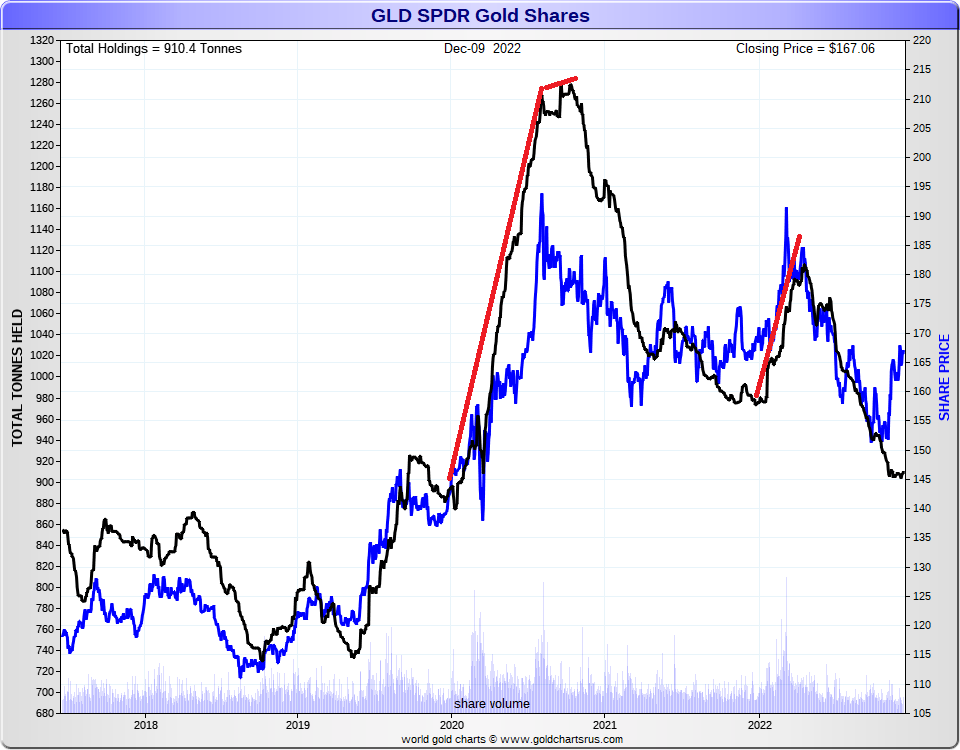
Before Q1 2022, the last multi-month period in which GLD’s gold holdings had surged dramatically was over the late March to early August 2020 period, during which GLD had added 360 tonnes of gold in a little over 4 months, expanding its gold holdings from 908 tonnes on 20 March 2020 to 1268 tonnes on 6 August 2020.
It was during this time between 15 April 2020 and 13 August 2020 that the SPDR Gold Trust held a large amount of gold at the Bank of England vaults (up to 70 tonnes at times) with the Bank of England as sub-custodian. See chart above.
It was also during this time between the end of March 2020 and the end of August 2020, that the Bank of England vaults saw a net outflow of 135 tonnes of gold.
In other words, on the last previous occasions where GLD has added a lot of gold quickly, it tapped the Bank of England for some of this gold, and this was specified in subsequent 10-Q (quarterly) and 10-K (annual) filings, as well as seen in the Bank of England vault data dropping. Which means that when GLD holds gold at the Bank of England vaults it does not show up in the Bank of England vault data (as this data only refers to gold holdings of central banks and bullion banks and not the gold holdings of ETF Trusts).
For a full description of what the Bank of England divulges in its gold vault reporting, see the BullionStar article here.
April 2020 onwards was also the time in which a) COMEX gold futures prices diverged on the upside relatively to the London gold spot price, b) Swiss refineries halted production, and c) gold bar shortages appeared due to supply constraints arising out of government lockdown policies brought in under the Covid guise.
This time around in Q1 2022, GLD has been (in its ‘Risk Factors’) warning about the potential disruption to the gold market due to Western and LBMA sanctions in light of the Russian – Ukrainian conflict. As the GLD Risk Factors said in the Q1 2022 10-Q:
“On March 6, 2022, the LBMA suspended its accreditation of six Russian precious metals refiners, hence suspending their access to the world’s largest gold market.”
Did LBMA and US Western sanctions against the Russian refiners beginning in February 2022 cause a shortage of other Good delivery gold among the GLD Authorised Participants (APs) and a need to source gold at the Bank of England?
Could it be that the same thing happened in both Q1 2020 and early Q2 2022? That as GLD gold holdings rose rapidly, some of this gold was being sourced at the Bank of England? But that since the GLD Sponsor has changed the wording of the 10-Q filings in Q1 2022, and since HSBC has added a potentially static column of ‘VAULT NAME’ with vault ‘HSBC VAULT’, then no one would know about the use of the Bank of England as a sub custodian?
Note that from 31 December 2021 to 31 March 2022, GLD added 115.77 tonnes, and GLD’s holdings rose from 975.66 tonnes on 31 December 2021 to 1091.44 tonnes on 31 March 2022. On a month to month basis, GLD added 42.1 tonnes of gold in January 2022, 11.3 tonnes in February, and 62.4 tonnes in March.
GLD then kept adding more gold until 20 April 2022 when it held 1106.74 tonnes, which was 131.08 tonnes more than on 31 December 2021, and 15.3 tonnes more than 31 March 2022. By 30 June 2022, GLD still held 1050.31 tonnes, or 74.64 tonnes more than on 31 December 2021.
The London Bullion Market Association (LBMA) even hinted at the trend in one of it’s recent vault commentaries (for August) that gold had been moving from the Bank of England vault to commercial vaults during 2022, where it says:
“As at end August 2022, the amount of gold held in London vaults was 9,565 tonnes (a 0.54% decrease on previous month), valued at $527.7billion, which equates to approximately 765,194 gold bars.
The ratio of gold held at the Bank of England versus the commercial vaults is the lowest since reporting started in July 2016.“
So that can only be true if gold was being taken from the Bank of England vaults (or reclassified out of the Bank of England vaults) at a faster rate than commercial vaults holdings were changing.
So it’s possible that some of this inflow into GLD was gold that was sourced from the Bank of England. If GLD did indeed add gold from the Bank of England during Q1 2022 and maybe during Q2 as well, and if this was not stated on 10-Q filings due to the change in SEC filings wording and the way the ‘HSBC Vault’ is defined, then WGTS is in breach of the SEC direction to “please disclose the amount of the Trust’s assets that are held by subcustodians.”
Conclusion
Revelations about when and how much gold the Bank of England vaults had been holding on behalf of the SPDR Gold Trust (GLD) had been a consistent feature of GLD reporting to the SEC over the last nearly decade. In fact, the SEC demanded that the GLD filings be transparent in showing this.
Then why did the GLD Sponsor suddenly stop providing this information, in Q1 2022 while telling interested parties to look at the www.spdrgoldshares.com website, where the GLD gold bar list file says nothing other than a vault location of ‘HSBC VAULT’? And why were these filing changes made during a quarter in which the GLD CFO had abruptly resigned mid way through the quarter?
Why were the 10-K and 10-Q report formats changed without any SEC authorisation and in a way that masked and suppressed the XRBL tags relating to subcustodians?
And why did the GLD Sponsor not want to be explicit in talking about GLD subcustodians during a period in which the Bank of England saw large outflows of gold and the GLD saw large inflows.
It should be the job of the SEC to ask these questions of the largest gold-backed ETF in the world. Instead it is left up to us.
Popular Blog Posts by Ronan Manly
 How Many Silver Bars Are in the LBMA's London Vaults?
How Many Silver Bars Are in the LBMA's London Vaults?
 ECB Gold Stored in 5 Locations, Won't Disclose Gold Bar List
ECB Gold Stored in 5 Locations, Won't Disclose Gold Bar List
 German Government Escalates War On Gold
German Government Escalates War On Gold
 Polish Central Bank Airlifts 8,000 Gold Bars From London
Polish Central Bank Airlifts 8,000 Gold Bars From London
 Quantum Leap as ABN AMRO Questions Gold Price Discovery
Quantum Leap as ABN AMRO Questions Gold Price Discovery
 How Militaries Use Gold Coins as Emergency Money
How Militaries Use Gold Coins as Emergency Money
 JP Morgan's Nowak Charged With Rigging Precious Metals
JP Morgan's Nowak Charged With Rigging Precious Metals
 Hungary Announces 10-Fold Jump in Gold Reserves
Hungary Announces 10-Fold Jump in Gold Reserves
 Planned in Advance by Central Banks: a 2020 System Reset
Planned in Advance by Central Banks: a 2020 System Reset
 Gold at All Time Highs amid Physical Gold Shortages
Gold at All Time Highs amid Physical Gold Shortages






 Ronan Manly
Ronan Manly 0 Comments
0 Comments










